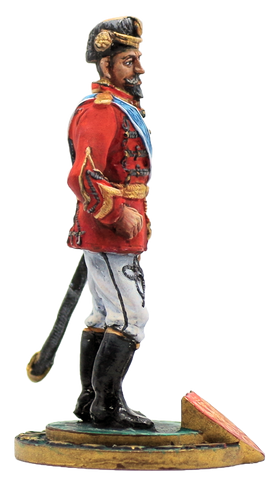
Mikhail Cantacuzène
Prince of Romania
Prince Mikhail Mikhailovich Cantacuzène, Count Speransky (29 April 1875 – 25 March 1955) was a Russian general. The title of Count Speransky has been alternatively spelled "Spiransky" and "Speranski". Prince Michael (or Mikhail) was Prince Mikhail Mikhailovich Cantacuzène, was born on 29 April 1875 in Poltava, Ukraine, then part of Imperial Russia. He was born at his family's estate which was known as Bouromka, in Poltava. The eldest of four children, he was a son of Prince Mikhail Rodionovich Cantacuzène and Elisabeth Sicard. His two younger brothers were Prince Boris (1876–1905) and Prince Serge (1884-1953) and his younger sister was Princess Daria (1878–1944). A member of the Cantacuzino family, a Russian branch of which is an offshoot of the Moldavian branch, the titles of Prince of Imperial Russia and of Count Speransky were confirmed to Mikhail's grandfather, Prince Rodion Nikolaevich Cantacuzène, in 1865 by Alexander II. The title had formerly been held by his great-grandfather, Mikhail Speransky, Russian statesman and one-time adviser to Tsar Alexander I. The Prince's father had inherited the Speransky title, unusually and on basis of special remainder, from his own maternal grandmother, Elisabeth Bagréeff-Speransky, who was a daughter of the first Count Speransky. The title of count was confirmed in 1872. The Russian princely titles of the Cantacuzène were inherited via the Romanian line of Cantacuzène, with the service of Michael's great-grandfather Radu,

Rodion Matveevich, Cantacuzène, who came from Romania to serve under Catherine the Great. His mother's family were French Huguenot merchants who also emigrated to Russia during the reign of Catherine the Great; her family's wealth included the estate of Bouromka, several apartments in St. Petersburg, a villa in the Crimea, and an apartment in Paris. His mother was exiled to Portuguese East Africa (Mozambique) and was buried in Macequece (now called Villa de Manica). Mikhail attended Page Corps in St. Petersburg, and later became a graduate of the Imperial Alexandrine Lycée.

The Rosiori were a type of cavalry unit in the Romanian Army. Active throughout the late 19th and early 20th centuries, the Rosiori were known for their vibrant red uniforms. The Rosiori were formed in 1868 during a period of modernization within the Romanian army. The result of these reforms was the formation of an irregular cavalry force (described in one source as being armed like Cossacks), the Calarasi, and a professional cavalry force, the Rosiori, who were armed and organized along the lines of the cavalry of the German Empire. The Rosiori wore scarlet hussar uniforms, white pantaloons, and white belts; some sources describe the units as the "Red Hussars".
The House of Cantacuzino (French: Cantacuzène) is a Romanian aristocratic family of Byzantine origin. The family gave a number of princes to Wallachia and Moldavia, and it claimed descent from a branch of the Byzantine Kantakouzenos family, specifically from Byzantine Emperor John VI Kantakouzenos (reigned 1347–1354). After the Russo-Ottoman War of 1710–11, a lateral branch of the family settled in Russia, receiving the princely (Knyaz, as opposed to Velikij Knyaz) status. Members of the family claim that the genealogical links between the Byzantine Greek and Romanian branches of the family have been extensively researched. The family first appears among the Phanariotes in the late 16th century, with Michael "seytanoglu" Kantakouzenos, after a gap of over a century from the Fall of Constantinople. Whether the family is indeed linked to the Byzantine imperial house of Kantakouzenos is disputed, as it was usual among wealthy Greeks of the time to assume Byzantine surnames and claim descent from the famous noble houses of their Byzantine past. The first member of the family to publicly stress his imperial

descent on an international level was the adventurer and pretender Radu Cantacuzino (1699–1761), who produced a genealogy linking himself to Emperor John VI Kantakouzenos, though it contained several invented figures. Radu also changed his coat of arms from the earlier arms depicting an eagle holding a cross, to a new rendition with more shields representing various families and regions, a version still in use by the family today.The eminent Byzantinist Steven Runciman considered the latter-day Kantakouzenoi "perhaps the only family whose claim to be in the direct line from Byzantine Emperors, as authentic", but according to the historian Donald Nicol, "Patriotic Rumanian historians have indeed labored to show that ... of all the Byzantine imperial families that of the Kantakouzenos is the only one which can truthfully be said to have survived to this day; but the line of succession after the middle of the fifteenth century is, to say the least, uncertain." The origin of the Byzantine family can be traced to Smyrna. The Greek scholar Konstantinos. Donald Nicol agrees with this theory, and lists some connections the Kantakouzenoi had with the locale in the 11th and 13th centuries. The Greek Kantakouzenos family had been active in Constantinople and Greece during the Greek War of Independence, but several branches of the original Greek family were created via the migrations and establishment of Kantakouzenos family members to different parts of Europe. Two of those new branches were the Romanian (Wallachian and Moldavian) Cantacuzino branch as well as the Russian branch (which is an offshoot of the Romanian-Moldavian one).
Awards: Insignia of the Imperial Order of Saint Stanislaus, Sash and star of the Order of the Crown of Romania.






